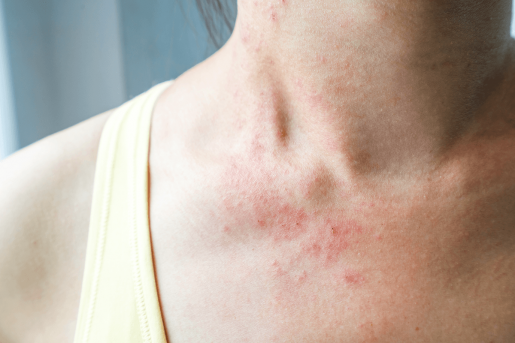Learn the difference between eczema, psoriasis and rosacea
They are three of the most common skin conditions and we asked Dr. Vicky Ren, a Baylor College of Medicine dermatologist, what you should know about eczema, psoriasis, and rosacea.

Eczema
“Eczema is a general term commonly used for various conditions, including atopic, contact, and stasis dermatitis,” explained Ren, Assistant Professor of Dermatology. This itchy, red, scaly rash is exacerbated by dry and sensitive skin, but the exact eczematous condition may have additional underlying causes.
When it comes to treatment of atopic dermatitis specifically, Ren recommends dry skin care measures, including short 5-10-minute showers with lukewarm water and fragrance-free soap, as well as bland emollients throughout the day. Prescription treatments include topical medications (e.g., steroids), phototherapy, and systemic medications (e.g., pills, injections).
Psoriasis
This chronic inflammatory disease is linked to genetic predisposition and environmental triggers. “Possible triggers and exacerbating factors include skin injury, infections, endocrine factors, drugs, stress, obesity, alcohol, and smoking,” Ren said. Lesions commonly appear as well-defined, inflamed, scaly plaques on the scalp, elbows, knees, lower back, genitals, hands, and feet. They can be asymptomatic or itchy and tender at times. Up to a third of patients may have or develop psoriatic arthritis. “Symptoms of psoriatic arthritis include prolonged morning stiffness, joint pain, and/or joint swelling in the small hand/foot joints or larger joints (e.g., wrists, hips, spine).”
Treatments include topical medications, phototherapy, and systemic medications.
Rosacea
While the exact cause of rosacea is unknown, immune and neurocutaneous dysregulation, vascular changes, ultraviolet and microbial exposure, and skin barrier disruption may all play a role. “Facial flushing and redness, telangiectasias (i.e., small blood vessels), pimple-like bumps, facial burning, stinging, and dryness are common symptoms,” Ren said. “Over time, there may be thickening of facial skin due to an overgrowth of oil glands or eye involvement with sensations of dryness, itchiness, or grittiness.”
Heat, sunlight, spicy foods, hot foods/beverages, emotional stress, alcohol, and foods such as chocolate and citrus can exacerbate symptoms. Ren recommends that patients use SPF 30+ sunscreen, exercise gentle skincare, and minimize/avoid triggers. Topical and systemic treatment options are available. For the redness associated with rosacea, treatments include topical alpha-agonists or vascular laser.
“All three conditions are considered chronic, but there can be periods of clearance/stability between flares,” she said. “Regular maintenance therapy is needed to help keep flare-ups at bay.”
Learn more about Baylor Medicine Dermatology.
By Anna Kiappes



